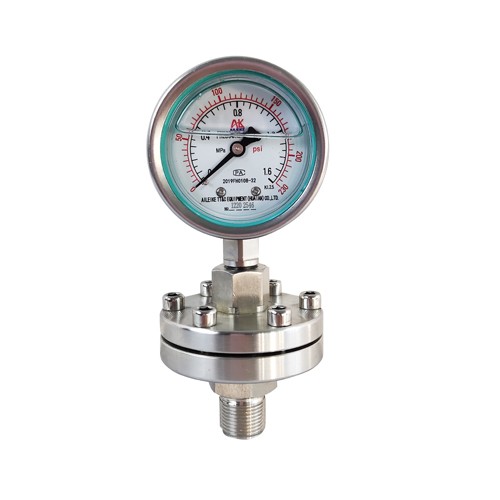Description
Diaphragm shock resistant pressure gauge y-60bfzml is used in petroleum, chemical industry, chemical fiber, dyeing and chemical industry, pharmaceutical industry, alkali food industry and other industries. Measure the pressure of corrosive, high viscosity, easy to crystallize, easy to solidify, high temperature liquid, gas or granular solid medium, and avoid the measuring medium directly entering the pressure instrument and prevent sediment accumulation and easy to clean
The pressure gauge is composed of pressure guiding system (including joint, spring tube, current limiting screw, etc.), gear transmission mechanism, number indicating device (pointer and dial) and shell (including case, cover, glass, etc.). The shell is airtight structure, which can effectively protect the internal parts from environmental impact and pollution invasion. For the instrument filled with liquid (usually silicone oil or glycerin) in the shell, it can resist the severe vibration of working environment and reduce the impact of medium pressure pulsation.
Corrosion resistance of diaphragm pressure gauge
The corrosion resistance of diaphragm pressure gauge can be ensured by proper selection of diaphragm, flange and sealing ring materials in contact with the measuring medium.
Diaphragm material:316 316L
Flange material:316 316L
Sealing ring material: silicone rubber, polytetrafluoroethylene
Accuracy grade: ±1.6%; Plus or minus 2.5%.
Case diameter: 60mm; 100 mm; 150 mm.
Case material: 304 stainless steel, 316 stainless steel.
Case form: Containment construction, clapboard device after release
Material of elastic element and joint body: 304; Argon arc welding of elastic element to joint body.
Movement material: 304 stainless steel, 316 stainless steel.
Joint thread: M14×1.5; G1/4; M20 x 1.5; 1/2 NPT, etc.
Measuring range: -0.1~0 MPa or,0.1~60 MPa
Pointer: Normal
Table glass: plexiglass
Shock resistant filling material glycerin 98% (silicone oil, fluorine oil or other categories can be selected)
Ambient temperature:
1) -25~70℃(liquid filled inside the shell)
2) -40~70℃(no liquid filling in the shell)
Temperature influence: not more than 0.4%/10℃(use temperature deviation from 20±5℃)
Anti-vibration of working environment: V·H·4 (liquid filled inside the shell)V·H·3 (liquid not filled inside the shell)








